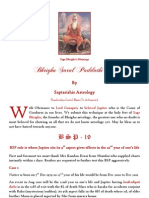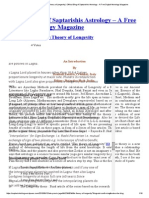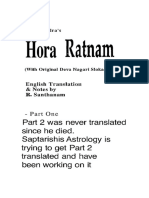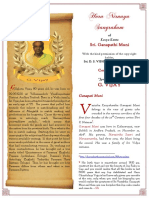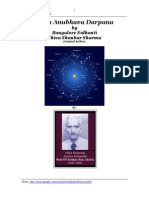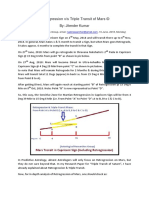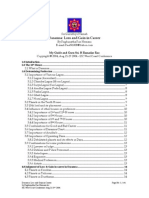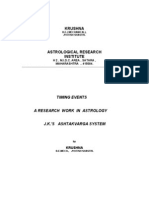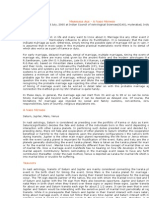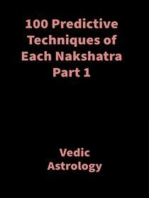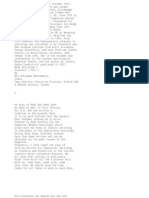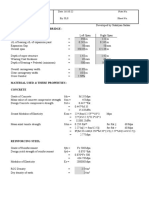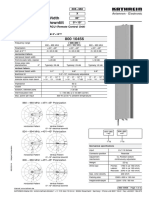NadiAstrology1DrBVRamanPart1Color Edited
NadiAstrology1DrBVRamanPart1Color Edited
Uploaded by
veena srivastavaCopyright:
Available Formats
NadiAstrology1DrBVRamanPart1Color Edited
NadiAstrology1DrBVRamanPart1Color Edited
Uploaded by
veena srivastavaCopyright
Available Formats
Share this document
Did you find this document useful?
Is this content inappropriate?
Copyright:
Available Formats
NadiAstrology1DrBVRamanPart1Color Edited
NadiAstrology1DrBVRamanPart1Color Edited
Uploaded by
veena srivastavaCopyright:
Available Formats
New Parchment 13th July copy To Dr Raman With Love Series Nadi Astrology Part 1 By Dr. B.V.
Raman SA Typing Volunteer: Manish Gour =Taken from The Astrological Magazine: Vol 66 No 10 Special Thanks: AIAC, Chicago Summary of a lecture delivered by the Raman Saheb at the Astrological Lodge, Lon don, on 25-9-1970 Mr. President, Ladies and Gentlemen:
hen I received a letter of invitation from my esteemed friend and your worthy President Mr. Ronald C Davison to address the well known Astrological Lodge of London I was not only gratified but a bit embarrassed also because Britain and India having had a close historical relationship for ne arly two centuries and having parted as good friends, it would in a sense mean renewing o ld ties of friendship and understanding; and embarrassed because Mr. Davison left the su bject of the talk to my choosing. However, it was not difficult for me to overcome thi s initial embarrassment because I could easily decide that the subject to be dealt with sh ould be the one that should not only be novel but also instructive to the members and I could not think of a more appropriate theme than Nadi astrology, a subject in which I have been making investigations for over twenty years I must also seek your indulgence in advance for having to use a number of Sanskrit terms, for which no suitable English word capable of conveying the spirit of the original could be thought of, even though I shall try my best to give the nearest corresponding words in English
Before I take up the subject-matter proper, I think I must tell you and I am sur e most of you already know certain distinctive features of Hindu Astrology and its
philosophy. Hindu astrology does not endorse the theory of absolute fatalism. As trology and the doctrine of Karma are intimately connected. According to Hindu philosoph ical work, man is a combination of a physical body, the mind and the self-conscious s elf or atman which is spiritually present. It is the individual s Karma or actions done i n past or previous lives that determine his present life. There are two main categories of Karma. viz., sanchita (accumulative) and prarabdha (operative). The present course of l ife is indicated by the prarabdha or operative Karma, I.e., deeds or actions whose seed has
already sprung up and whose machinery has been set in motion towards their fruit ion in the present life. The sanchita or Accumulative Karma pertains to actions that ar e still lying latent like seeds stocked up in a granary for fruition in future lives. Th e horoscope Indicates our past Karma, the parabadha or operative portion of our Karma being our destiny in this life and that astrological predictions are tendencies of nature on their way towards fulfillment or manifestation and that to some extent we can either stren gthen or weaken their momentum in the direction desired by suitable remedial measures. New Parchment 13th July copy The celebrated ancient astrologer Varahamihira whose works are still considered authoritative, points out that astrology reveal the lines along which the destin y of individuals would be unfolded.
The first and the most important of the distinctive features of Hindu astrology is that it is based on the so called fixed or sidereal zodiac This is divided into 12 parts called the signs of the zodiac or 27 equal parts or asterisms or Nakshatras of 13 20 each . The fitting of the first point of the zodiac - the end of the constellation Revati w hich some identify with the modern Zeta Piscium so as to make it the same for all time is an important feature of Hindu astrology and this shows a fundamental difference fro m the European system of reckoning in which all longitudes are measured by arcs of the ecliptic the origin being the equinoctial point at the time of observation. This does not =mean that precession was not known to the Hindus. The very Sanskrit terms Sayan a and Nirayana to distinguish between the two zodiacs mean, with precession and without precession. In fact the precession of the equinoxes was discovered by ou r Sages long before anything about it was known to any other nation. In actual practice, it is the arcs of 13 20 measured from the 1st point of stellar Aries that are really importa nt for astrological purposes. They of course bear the names of the brightest stars or Y ogataras of the star-clusters that lie on or near about the arcs concerned. I
n India astrology continues to occupy a very important place socially and
culturally, in the lives of the majority of Indians, whose requirements of astrological consultations are generally dealt with by astrologers well versed in the traditional system, which are preserved even unto this day in the same fo rm, as they perhaps existed three or four thousand years ago. The stars and constellati ons have been associated with Hindu astrology from times immemorial and their significanc e in prediction is considerable. Nor does Hindu astrology take into account the extra , Saturnine planets, viz., Uranus, Neptune and Pluto. The Moon s ascending Node, viz , Rahu and the Moon s descending Node, viz. Ketu are given great prominence. Even though the Hindus are aware that the Sun is a star; the moon a satellite of the earth; and the Nodes, points of intersection between the orbits of the Sun and Moon all these were termed planets for astrological purposes. The term =planet for the Sun, the Moon
and the Nodes in modern astronomical parlances is no doubt a misnomer, but the Hindus had their own reasons to call them grahas, which for want of a better ter m, in English, we call planets. Graha in Sanskrit means .Centre of Energy. capable of the properties of attraction and repulsion. You will thus see that in Hindu astrolog y when the term planet is used it may be the Sun, the Moon, Mars, Mercury, Jupiter, Ven us, Saturn or the Moon s ascending or descending Node. It is mainly on the nine planet s, 12 signs and 27 constellations that the entire predictive art of the Hindus has bee n developed. New Parchment 13th July copy Some of the general principles such as rulerships, exaltations, etc., are common to both the Hindu and Western systems. But regarding aspects, there is divergence. For example, Western astrology considers a square or an opposition as always bad and a trine or a sextile as always good. According to the Hindu system, however, no aspect b y itself can be good or bad. It is the nature of the planets involved in the aspect and t he type of ownership they hold with reference to the Ascendant, that determines the nature of the aspect. An aspect like the Moon- Jupiter square or opposition, in the words of l ate Mr. Carter, denotes in addition to the .same good humor that we find with the good a spects, a more restless and sometimes even combative disposition.. But I think on the wh ole you consider a square aspect as bad. But according to Hindu astrology such a dis position causes what is called Gajakesari Yoga indicating respect, name, fame and positio n. Even here, the nature and extent of fame or position rests upon the type of lordship, the two planets hold with reference to the Ascendant, the nature of the Constellations h eld by them and the vitality the two planets have secured and so many other factors suc h as their dispositions in the various sub-divisions etc. Where, for example the Asce ndant is Sagittarius with Jupiter in the Constellation of Moola (i.e. the 19th) and the M oon is in Pisces- In the constellation of Poorvabhadra (25th), the fame and name will be o n the plane of philosophy, but of a non-traditional type because Jupiter would be in t he constellation of the Moon s descending Node, while the Moon is powerfully placed a s he occupies both the sign and constellation of Jupiter or again if we take Virgo as Ascendant and Jupiter in Libra in the constellation of the Node(swati -15th) and the Moon
in Aries in the constellation of Venus(Bharani-the 2nd) it is indeed a splendid combinati on for success and fame in occult matters which in a sense includes astrology, theosoph y, and possibly psychology. In such a Yoga, Jupiter aspects the 6th house giving opposi tion, antagonism and also success over the opponents, while his aspect on the 10th is generally favored as it gives the person certain settled convictions, and also the faculty of prevision.
The other distinctive features of Hindu astrology are yogas or typical combinations of planets which enable us to ascertain clearly the rank and status of a person, and the Dasas or methods of progression enabling one to time events:
The Nadis or Nadi granthas are compilations by the masters of the science of astrology the Maharishis or the Sages the very same master minds who have written treatises on every aspect of Indian Culture and whose forte was observation and meditation. They contain not only hundreds and thousands of readymade horoscopes and horoscope-patterns but also vast astrological formulae. New Parchment 13th July copy The Nadi literature should be regarded as absolutely special and original to Ind ian Culture and genius: While the West has been able to achieve remarkable control o ver the forces of nature, in the development of star-lore the achievements of India are indeed noteworthy. Until perhaps 1930 s Nadi astrology was a sealed book to many of the H indu astrologers themselves as they could not procure the texts. They were available, as palmleaf records in various Indian languages- Sanskrit, Tamil and Telugu and deposited in temples or their trustees, and somehow came into the hands of uncultured people who played a lucrative trade with them. It is about 25 years ago that a Nadigranth, that is, a work on the Nadi system came into my possession. I am working on an English translation of this work and God willing I expect to publish it early1. The work , I am sure, will make a definite contribution to predictive astrology by placing in th e hands of astrologers reliable methods of prediction. 1 This lecture was delivered in 1970 and 25 years ago would mean 1945, is Dr Ram an referring to Dhruva Nadi and the translation publication of it is still an unfinished task. Please write with politeness and enough encou ragement to the descendants of Dr Raman to part with this translation for the benefit of astro community. If we remember well it could not be Dhruva nadi that Dr Raman is referring to since as per our weak memory it was in 1953 that he was handed over the Dhruva Nadi leaves along w ith the Code Book . Pls remember without code book it is almost impossible to decipher the underlying/hidden techniques mentioned in a nadi, this aspect is not known to many astrologers. Again writing from memory that in a letter dated to KN Rao somewhere in 1992/93, publi shed in KNRs Ups and Downs in Career , that he (Dr Raman) has given up astrology and only concentrating on publishing Dhruva Nadi, this shows the importance of Dhruva Nadi taking into light a great astrologer retiring from astrology and also inspite of knowing San skrit published only few translations of manuscripts and took to a great nadi translation at his old age post jyotish retirement. SA Publisher.
I have heard it said by some of my learned astrologer-friends in the West that t he .key to astrology was lost with the burning of the library at Alexandria or It p erished
with the Atlantis people. and so on. But in India at least the key appears to be quite intact, perhaps because of a certain continuity of culture for thousands of year s and because of the fact that astrological knowledge is still being taught orally in the shape of aphorisms or certain code language.
Hundreds and thousandth of people make use of the recorded horoscopes contained in the Nadis for knowing not only their future in this life but also a bout their past lives. There are different types of these Nadis. Some of them give entire l ifehistories of persons in each case substantiating their deductions by astrological reasoning while others merely give predictions of both the past and the future w ithout
much astrological discussion. There are yet others, which merely give the horosc ope on the basis of certain palm lines, the delineation being left to be looked into in other works. But the bulk of them are based on radical or birth horoscopes. The horoscope whe n correctly traced indicates the entire life-history of an individual from cradle to the grave. Easy or difficult child-birth, description of the lying in chamber, birthplace i n reference to village, town, city, etc., caste, details about: the parents, number of broth ers and sisters alive and dead, education, future attainments, number of marriages, private life , diseases, friends and enemies and a lot of other details pertaining to an individual are s tated. New Parchment 13th July copy The various charts given should be taken as typical and representative or symbol ic and they can be fitted into a person s horoscope, which has almost a similar patte rn. Thus for a given horoscope, many judgments are given, which agree with one anoth er to a period and then differ. I think even Sepharial refers to the Nadis in one of h is works. My revered grandfather, the late Prof. B. Suryanarian Rao used to tell me that w hen Sepharial met him about 60 years ago and his reading was read from the Sukra Nadi, he was almost dumbfounded at the uncanny way in which his life had been revealed. There are a number of Nadis scattered in different parts of India. In North India they are known by th e name of Samhitas. Some of the Nadis I have seen and examined are Guru Nadi, Sukra Nad i, Markandya Nadi, Nandi Nadi, Kowmara Nadi, Suka Nadi, Budha Nadi, Sarwaswati Nadi , Dhruva Nadi and Satya Nadi. Each Nadi sets before it a certain number of particu lar questions relating to life-incidents that appealed to the authors to be of real value to the people. Some of these Nadis are also available in Oriental Libraries in India bu t in most cases, the keys are lost so that it is rather difficult to trace the pattern of the horoscope required. Chandra Nadi, for instance is available in a mutilated condition in th e Oriental Manuscripts Library at Madras2. Generally each Nadi work is classified into 12 p arts.- each part dealing with one house of the horoscope. Each of these twelve parts is agai n divided into nine sub-parts corresponding to the nine Navamsas or 1/9th divisions of a s ign or into 12 sub-parts corresponding to the 12 Dwadasamsas or 1/12 division. Then the re are the Dasas and Bhuktis or progressions. These palm leaves contain predictions of
events on the basis of the main periods and sub-periods. The reading starting from the time of birth and covering the important landmarks till the time of consultation and fur ther on till time of death. Three more parts deal with what are called Yogakhanda, Karma khanda and Shantikhanda. The yogakhanada gives with fairly accurately one s spiritual, po litical scientific and social attainments, the degree of status and wealth, sudden eleva tions and falls and significant fortunes and misfortunes with appropriate planetary combin ations. In Karmakhana are enumerated the sins one is supposed to have committed in one s p ast life and in what manner the effects of such sins have manifested up to the time of 2 Can any savior of astrology go to Madras and get this nadi, photocopy it and u pload it for the benefit of astrological community. SA Publisher.
consultation, and will manifest in the remaining part of this life. And in the ShantiKhanda are prescribed remedial measures which consist of medicines, yogic practices and mantras or certain regulated forms of sound vibrations to ward off or minimize the evil. New Parchment 13th July copy Some of the Nadis are voluminous. For instance, Saraswathi Nadi3 has about 1000 bundles of palm leaves, each bundle having about 200 leaves each leaf measuring about 8. X 2.. One bundle contains at least not less than 50 horoscopes. So that the w ork as a whole has nearly 50,000 horoscopes. 3 In every 3rd street of India, you could find an astrologer or an astrological organization or astro trust or astro school, many of them getting innumerable donations. Each astrologer prays to Goddess Saraswathi for knowledge and are in debt to her for their knowledge, yet no one considers it their moral duty to procure the Saraswathi Nadi and release it for the astrological community. This trend of being ungrateful and commercial crusaders of astrology has now continued with the western organizatio ns who are more interested in promoting themselves in their own conferences and doing no meaningful work. Both the west and east have failed miserably in the last 100 years of astrological organizations/astro schools yet they take every opportunity to boast of their ac hievements, we indebted to our Rishis and Gods for the astro knowledge and this Rishi Rin (debt) we must pay back first by bringing their lit erature out. Now the future of real astrology of the sages is left in the hands of the Indigo Children who will break the shackles of Throne & Doll ar Astrology. SA Publisher 4 It is next to impossible to give the logic of a Rishis reading and any attempt in logic presentation is of the writer and not of the rishi, this must not be forgotten. Let us take the timing of events via Bhrighu Chakra Paddathi ( BCP one year one house) and use it broadly on some of the predictions given by Sage Satyacharya on the chart of Mahatma Gandhi. Rishi says At the age of 20 he will go to a foreign country this is the 8H being activated at 20, the 8L of change is in most important house Asc (m ost significant changes happen when Asc comes into play in BCP) and 8L Venus is with 9L & 12L of abroad Mercury, along with Mars a maraca f or Libra Asc. One rare usage of maraca is Separation ; he got separated from his family. Then Sage says His mother will die at the age of 2 2 in his absence the 22nd year will be 10H where Moon (mother) in own sign is placed with Rahu (separation and karmic axis). Then Sage says His father will die when he is 16 the 16th year would be 4H, ideally it should be 3H since as per BPHS the 3H indicates parents death, but note that when a house has been passed in the progression method, it will get activated and can give results in succeeding hou ses. Anyways the 4H is the 8th from 9H of father and a danger house even if one takes 10H as father. The 4L is in 2H of family which means som e event in family and it is in 6th of troubles from 9h of father, now 4H has Ketu which signifies Exit and his father exited. Young ones should no t interpret the above brief explanation blindly taking for every chart having Ketu in 4H as exit time for father in 16th year, only when yo u are mature enough in astrology behind every technique you would subconsciously use Transits and dasas without even looking at it. Jupiter destroys one thing in the 8th and 10th from it is a BSP rule and
here Jupiter is 3L of parents death and aspects by 10th aspect the 4H which is a ctivated in the 16th year with the 8L of death, Venus MD being
There is one work called Satyasamhita in which as early as 1935, the horoscope o f Mahatma Gandhi and Kind George V could be traced. This Satyasamhita is stupendou s work consisting of 125 volumes. Each volume in its turn has 300 palm leaves. Its author is supposed to be Satyacharya, a very honored name in classical Hindu astrology who is said to have lived about 2000 years ago gracing the illustrious court of Emperor Vikramaditya, the last and the most colorful of Hindu monarchs. The amazing part of this work is that terms nyayavadi and nyayadarsi are used to denote modern disti nctions between advocate and a solicitor. The Satyasamhita has the following to say abou t Mahatma Gandhi s horoscope. The native will be born in a holy city on the coast of the ocean. His father will be Dewan or Prime minister. At the age of 20 he will go t o a foreign country. His mother will die at the age of 22 in his absence. His father will die when he is 16. He will have four sons of whom three will be engaged. He will mar ry at 13. At 32, he will be lawyer4. He will consider the whole world as his family; will always
operational, some death has to happen. Then the Sage says He will marry at 13 how to see early marriage is not known to us astrologers, using BCP 13th year would be the 1H of natal chart, which activates Venus (marri age) and Mars the 7L of marriage and Mercury the 9L of dharmic marriage as all 3 are placed in 1H. One technique from elderly Mr. Mani, a giant of a traditional astrologer who is one of the few to be instantly awarded Ph.D upon being tested on blind charts by Banaras Hindu Univer sity is that when 8L is in Kendra marriage is not that great or divorce or denial, the power of damage increasing from 1H to 10H, it works in the case of Mahatma Gandhi with 8L Venus in 1H, his marriage in the traditional sense was a failure but in the spiritual sense was t he finest that ever can be of true soul mates. SA Publisher speak truth and will be pure-hearted. Pride and arrogance will not touch him. Th ere will be no distinction between his thoughts, words and deeds. While living as a griha stha or householder he will live as a hermit at hearth. At 62, he will be very unhappy w hen running through the period of Rahu. At age of 66, he will fare well and achieve some suc cess in his mission. Before 65, he will profitably meet the Emperor of the white people. His father will have more than one wife and will be born of the second wife. He will resort to fast for the good of the world and will live above 70.. New Parchment 13th July copy But it is Dhruva Nadi and Sukra Nadi that are really superb. They not only give horoscopic patterns but also horoscopic discussions. I would like to give a summ ary of a horoscope picked at random from Sukra Nadi. It reads as follows:-
.The person who has Komalamsa point(Taurus) (Komalamsa of Taurus is the 41st par t of the Shashtyamsa being an even sign lies between 9 30 and 10. However this degree do es not give the correct position as per explanations given below for Drekkana, Navamsa etc.) rising at b irth is born in a small town near a temple of God Shiva, in the house of his relative. If the 2nd part o f this amsa or sensitive point (Taurus) is rising, then the birth would be within the precin cts of a temple itself. Jupiter in exaltation occupying the Navamsa(1/9th division) of Sc orpio, and Saturn in Leo occupying the Navamsa(1/9th division) of Aries, and the Sun in Sagittarius, birth will be on a Thursday, in the dark half of the lunar month, i n the 1st quarter of asterism of Pushya(8th star) (The Navamsa position of Moon would be i n Leo). The appearance of the head will be in Taurus itself. The birth will be in the hora ( half division) of the Moon (Being an even sign the degree must be within 15 to be pla ced in the hora of Moon) and Drekkana (decanate) of Virgo (Virgo is the 5th sign from Taurus and hence th
e Lagna degree must fall between 11 and 20 but as per Hora it cannot exceed 15 and hence Lagna must be between 11 and 15), Navamsa (1/9) of Taurus, (For Taurus we count from Capricorn the 9 sub divisions to arri ve at the Navamsa. Taurus Navamsa means it is in the 5th portion meaning 4 x 3 20 = 1320 must have been over i n Taurus and it cannot exceed 15 degree as above. So Lagna must lie between 13 21 and 15) and Trimsamsa (1/ 30th division) of Jupiter (Taurus being an even sign- the first 5 signs i.e. upto 5 are ruled by Ve nus; the next 7 parts i.e. from 5 01 to 12 are ruled by Mercury; the next 8 parts beginning from 12 01 to 20 are ruled by Jupiter; the next 5 parts by Saturn i.e. from 20 01 to 25 and last 5 parts viz. from 25 01 to 30 are ruled by Ma rs-Since the ruling planet is stated to be Jupiter then the degree of Lagna must lie between 12 01 to 20 which in our case will get reduced to the range 1321 to 15 as per position of Navamsa lagna stated above).. As the Ascend ant is aspected by Mercury the mother will have suffered only ordinary labour pains at the time of his birth. If the birth is in the 2nd half of the sensitive point, the labour will b e difficult. As
the lord of the 9th is in inimical house (it is Leo here) he will not have much happiness from father. Having been born in the Komalamsa of Taurus Ascendant the Trimsamsa (1/30th part) being that of Jupiter he will have a golden colored complexion. He will be highly intelligent with a well-proportioned body. Not avaricious, he will posses s a bilious constitution. As the lord of the 2nd house is aspected by Mars (Mars can be in A ries (8th aspect on Scorpio) or Taurus (7th aspect on Scorpio or in Leo (4th aspect) and the best position would be Lagna) and as the 2nd house is aspected by the Sun, he will be sensual in his thoughts and cap able of knowing others minds. New Parchment 13th July copy Highly learned, he will not only be an expert in three languages, but a capable writer also. The 10th lord being in the sign of the Sun, his occupation would be that of serving others. As the lord of the 4th house Sun is in the 8th and the Moon is in the 3r d in her own sign with exalted Jupiter, he will have happiness from mother who will be a good natured lady highly devoted to her husband. In the main and sub-periods of lord of the 2nd asterism from that of birth, when Jupiter transits the end of Pisces, mother s death takes place. Lord of the 11th Jupiter exalted and in the sensitive part of Kinna ramsa, (Kinnaramsa is the 55th part of Cancer (being an even sign) and lies between 02 3 0 and 03 of Cancer) and the ascending Node occupying the 11th, the elder brother will be a famous author. He will marry in the main period of 2nd asterism-lord, in his 21st year when Jupiter tra nsits Aries.. The length of life given is 68 years, death taking place when the Sun tr ansits his debilitation sign, on a Wednesday.
Nadi-Raman-1.jpg
Nadi-Raman-1-Navamsa.jpg New Parchment 13th July copy In a detailed reading the vitality or otherwise of the various lords have been discussed and the main periods sub periods and the transit positions in which di fferent events take place, are all given.
A careful investigation of these various Nadi Granthas has revealed certain very interesting factors, which may be of great practical importance to astrologers Hin du or Western and which when properly made may enable us to make predictions with a degree of accuracy that is conspicuous by its impossibility today. It is also cl ear that the Nadi writers, in formulating their methods of predictions, have made use of the exhaustive literature on astrology attributed to Sage Parasara. Most of the grea t mass of this literature has been reduced into the form of sutras or apothegms for securi ng brevity and concentration and also as memory aids. Each sign of the zodiac has been divi ded Into 150 parts called amsams. Each division thus comprises an arc of 12 or about 48 se conds of time. Each of these 150 divisions of a sign is given a certain proper name, such as Vasudha, Vaishriavi, Brahmee, etc., and in a certain order which holds good in a ll movable signs. The order is reversed in the case of fixed signs. Thus, while the first n adi amsa of Aries, Cancer, Libra, Aquarius is Vasudha, the same unit will be the last in Tau rus, Leo, Scorpio and Aquarius. In the case of dual or common signs Gemini, Virgo, Sagittar ius and Pisces the count commences from the 76th amsa. The name assigned to the first unit of a movable, the last unit of a fixed and the 76th unit of common sign is the same.
This minute unit or amsa of 12
of arc is again sub-divided into the first and the
second parts so that actually, the time of birth should be determined with very great precision (24 seconds). The results are bound to vary with each such minute. Whi le birth in the 1st part of this unit in Aries (i.e., Aries 0 6 ) Ascendant makes one an educationist, birth in the 2nd part (Aries 6 to 12 ) makes one a politician. In Tau rus for instance, the 5th unit refers to the horoscope of a hawker; the 7th to that of a dancing girl, the next one to that of a magician, the next one to an engineer. One born in the next unit of course with certain definite types of planetary grouping will make one a gr
eat
king who lives for 110 years but who by his yogic power will increase it ten-fol d. It is also hinted that no such human being would be born in the Kaliyuga or the presen t Iron Age in this particular unit and particular grouping. Nadi astrology makes it oblig atory that prediction should be given only after a careful scrutiny of not only this s pecific amsa or unit from amidst the 150 but also the other 9 sub-division into which a sign is divided. The other 9 divisions are Shashtyamsa (1/60th), Trimsamsa (1/30th), Shodasamsa ( 1/16th), Dwadasamsa (1/12th), Navamsa (1/9th). Saptamsa (1/7th), Drekkana (decanate) and Hora (1/2). The lords of the sub-divisions occupied by the nine planets and the Ascen dant should be determined. New Parchment 13th July copy The minute unit (that is 1/150th part of a sign) that is exactly on the eastern horizon at the time of birth is the principal indicator of the course of life an d the fortunes and misfortunes a person faces. It looks as though a certain pattern of events i s shown within this small compass of 12 of arc. Since in the whole zodiac there are 3,600 such divisions, there are obviously 3,600 basic pattern of destiny. Each of these patterns turns up once each day, due to the apparent revolution of the zodiac. It is these =patterns that ide ally form the basis of all secondary analysis furnished by the asterism in which the plane ts are found. The actual Ascendant is the very zodiacal point which is coming up over t he horizon at the moment of birth. In strict fact, this zodiacal point should be lo cated up to six minutes of space. A difference of six minutes of space marks a world of diff erence. It places a birth in an entirely different pattern of destiny. But during a whole s eries of minutes at twilight if Sagittarius or Capricorn be seen on the horizon birth wil l be followed by Instant death. Twilight is the period of 48 minutes before sunrise a nd after sunset. It therefore follows that from December 15th to February 14th birth in t he early dawn or from May 15th to July 15th immediately after night fall is generally invested wi th fatal possibilities. A statistical vindication of this finding of Sages is a contrIbut1on which an ea rnest researcher owes to astrology.
According to Nadi astrology, the moment of birth has to be determined by reference to three phenomena. One is adhana or the moment of conception; the sec ond is
sirodaya or the first appearance of the head of the child; the third is bhupatan a or the actual moment of the contact of the child with the earth. Of these three which i s to be preferred? Satyacharya is emphatic that the first and the second, viz., concepti on and the appearance of the head cannot be correctly determined so that the third i.e., ac tual birth is alone to be taken. Questions such as what constitute the moment of contact wi th the earth may be asked. The nurse or the obstetrician may receive the child first. C an this be taken as the moment of birth because the nurse or the obstetrician stands on the earth? The original Sanskrit word, bhupatana, is clear and specific, i.e., the moment o f being dropped on the earth. It is this moment that should be related to the basic unit or amsa. There are so many practical difficulties to note down such a moment. Perhaps
anticipating such difficulties, Satyacharya says that as it is improbable that t he exact moment of birth would be recorded, the astrologer should determine it on the bas is of his experience and skill. He then gives a number of details such as the nature of pl ace of birth, the caste; the surroundings, number of brothers, etc., which would be the case in respect of each amsa.
To Be Continued
End flower New Parchment 13th July copy
You might also like
- Active, Reactive Apparent Power Assignment Student Template Fall 2020Document8 pagesActive, Reactive Apparent Power Assignment Student Template Fall 2020GabrielGreco100% (1)
- Stellar EffectsDocument4 pagesStellar Effectspm plassanalNo ratings yet
- Orbital Providence (Scholarly Exposition on Naadi Astrology)From EverandOrbital Providence (Scholarly Exposition on Naadi Astrology)No ratings yet
- Astrology For Layman: The most comprehensible book to learn astrologyFrom EverandAstrology For Layman: The most comprehensible book to learn astrologyRating: 1 out of 5 stars1/5 (1)
- Bhrighu Saral Paddathi - 33: by Saptarishis AstrologyDocument8 pagesBhrighu Saral Paddathi - 33: by Saptarishis AstrologyAnonymous y3hYf50mTNo ratings yet
- Journal of Astrology Article On MS Subbhalakshmi HoroscopeDocument11 pagesJournal of Astrology Article On MS Subbhalakshmi HoroscopeVaishnavi ShridharNo ratings yet
- BSP 19BWDocument8 pagesBSP 19BWRakesh SoniNo ratings yet
- Late Pravin Jagad's Theory of Longevity - Official Blog of Saptarishis Astrology - A Free Digital Astrology MagazineDocument16 pagesLate Pravin Jagad's Theory of Longevity - Official Blog of Saptarishis Astrology - A Free Digital Astrology MagazineShrikant Rai Rai100% (1)
- Why Astrologers Must Also Apologize BWDocument2 pagesWhy Astrologers Must Also Apologize BWGargaNo ratings yet
- Hora Ratnam SanthanamDocument945 pagesHora Ratnam Santhanamrmartincastro8534No ratings yet
- Garga Hora SastraDocument91 pagesGarga Hora SastraGuru RamanathanNo ratings yet
- Combinations For Successful LawyersDocument3 pagesCombinations For Successful Lawyersvijay kumarNo ratings yet
- RKFTD Esa Fookg Lge, Oa Lire Hkko Fopkj:) KJK JKDS'K Lksuh) T IqjDocument14 pagesRKFTD Esa Fookg Lge, Oa Lire Hkko Fopkj:) KJK JKDS'K Lksuh) T IqjAshutosh SharmaNo ratings yet
- When You Fallin Love BWDocument12 pagesWhen You Fallin Love BWGargaNo ratings yet
- Sapthanadi Chakra PDFDocument3 pagesSapthanadi Chakra PDFMarket NewsNo ratings yet
- RBT by Raghunatha Rao NemaniDocument23 pagesRBT by Raghunatha Rao Nemaniswami_omkarNo ratings yet
- AkpDocument34 pagesAkpRaman SharmaNo ratings yet
- KP Prashna AstrologyDocument10 pagesKP Prashna AstrologybhagyaratnaNo ratings yet
- Latest Books On Hindu (Vedic) Astrology S.No. Books & Authors Names RsDocument2 pagesLatest Books On Hindu (Vedic) Astrology S.No. Books & Authors Names Rsuma murtyNo ratings yet
- Laghu Parashari Part 1Document2 pagesLaghu Parashari Part 1Nandkishore GitteNo ratings yet
- Astrology Hora NirnayaDocument43 pagesAstrology Hora NirnayaSudhir KumarNo ratings yet
- Jupiter in Dual SignsDocument11 pagesJupiter in Dual SignspgurNo ratings yet
- FbtechDocument16 pagesFbtechsunehali sharmaNo ratings yet
- 01 Lal Kitab Concept - Nabalig - Balig KundaliDocument3 pages01 Lal Kitab Concept - Nabalig - Balig Kundalisorena0842100% (1)
- Brighu Chakra Paddhati - WWW - lightOnVedicAstrologyDocument6 pagesBrighu Chakra Paddhati - WWW - lightOnVedicAstrologyAnonymous 2eQM4wN11No ratings yet
- Jyotish 1989 Vedanga Jyotisha Prabhakar Vyankatesh HolayDocument126 pagesJyotish 1989 Vedanga Jyotisha Prabhakar Vyankatesh HolayJagadish GowdaNo ratings yet
- Father - 9th or 10th HouseDocument1 pageFather - 9th or 10th HousepblsvramanNo ratings yet
- PVKPRDocument2 pagesPVKPRhk_scribdd100% (1)
- 6 Fold Table in KPDocument12 pages6 Fold Table in KPponnyatheinnaing1329No ratings yet
- Bhrighusaralpaddathi 23bwDocument9 pagesBhrighusaralpaddathi 23bwPrakash Chandra TripathyNo ratings yet
- Bhrigu Saral Paddhati Aka BSPDocument3 pagesBhrigu Saral Paddhati Aka BSPAstrologer in Dubai Call 0586846501No ratings yet
- Hora Anubhava Darpana: by Bangalore Sidhanti Shiva Shankar SharmaDocument20 pagesHora Anubhava Darpana: by Bangalore Sidhanti Shiva Shankar SharmapandeypunitNo ratings yet
- MA-Ezine-DECEMBER 2021Document89 pagesMA-Ezine-DECEMBER 2021Palar yarNo ratings yet
- NadiDocument2 pagesNadiDidier G PeñuelaNo ratings yet
- Guru Nadi - Full 3 PartsDocument35 pagesGuru Nadi - Full 3 Partspm plassanalNo ratings yet
- Chara Dasha and Sthira DasaDocument5 pagesChara Dasha and Sthira DasaAdya TripathiNo ratings yet
- By Dr. Arjun Pai, India.: Sage Bhrighu's BlessingsDocument9 pagesBy Dr. Arjun Pai, India.: Sage Bhrighu's BlessingsAnonymous jGdHMEODVmNo ratings yet
- Madhya ParashariDocument1 pageMadhya ParashariChristopher FowlerNo ratings yet
- Bhrigu SutrasDocument99 pagesBhrigu SutrasTremayne HansenNo ratings yet
- Ayanamsa IssueDocument9 pagesAyanamsa IssueSampathKumarGodavarthiNo ratings yet
- Mars Retrogression & Triple TransitDocument2 pagesMars Retrogression & Triple TransitsnmurthypNo ratings yet
- Dasamsa-Gain or Loss Careers-By Raghunatha-JiDocument64 pagesDasamsa-Gain or Loss Careers-By Raghunatha-JisimonloongNo ratings yet
- Krushna: H 2, M.I.D.C. Area, Satara, MAHARASHTRA .. 415004Document7 pagesKrushna: H 2, M.I.D.C. Area, Satara, MAHARASHTRA .. 415004Subramaniam Raju Krishnan100% (1)
- Collected Papers On Jyotisha (Jyotish Shoda Lekhavali) Kuppanna Sastry T.S. Rashtriya Sanskrit SansthanDocument480 pagesCollected Papers On Jyotisha (Jyotish Shoda Lekhavali) Kuppanna Sastry T.S. Rashtriya Sanskrit SansthanVamsi KumarNo ratings yet
- M A - A N M: Arriage GE ADI EthodDocument2 pagesM A - A N M: Arriage GE ADI EthodPeter NovakNo ratings yet
- सिद्धान्त दर्पण-भूमिका खण्डDocument162 pagesसिद्धान्त दर्पण-भूमिका खण्डArun Kumar UpadhyayNo ratings yet
- Argala and 10th HouseDocument4 pagesArgala and 10th HouseKrishna CHNo ratings yet
- BADHAKDocument1 pageBADHAKAnekk SadhNo ratings yet
- Explains ParyayasDocument3 pagesExplains ParyayasRohit SahuNo ratings yet
- Kalpalataa - 1: Éï Aéhéåzééré LéqéèDocument24 pagesKalpalataa - 1: Éï Aéhéåzééré LéqéèPrakash Chandra Tripathy100% (1)
- Microscopy of Happy Living – Don’T Worry Be Positive - Start Living Be Positive Be Brave Be Strong and Be HappyFrom EverandMicroscopy of Happy Living – Don’T Worry Be Positive - Start Living Be Positive Be Brave Be Strong and Be HappyNo ratings yet
- Prediction Secrets Eastern Methods for Prediction: Prediction Secrets, #1From EverandPrediction Secrets Eastern Methods for Prediction: Prediction Secrets, #1No ratings yet
- 100 Predictive Techniques of Each Nakshatra Part 1: Vedic AstrologyFrom Everand100 Predictive Techniques of Each Nakshatra Part 1: Vedic AstrologyNo ratings yet
- Transit in NadiDocument10 pagesTransit in Nadiveena srivastavaNo ratings yet
- Timing of Marriage - by AshDocument11 pagesTiming of Marriage - by AshAnupam TiwariNo ratings yet
- Nadi Astrology and Transits Part 1 B WDocument33 pagesNadi Astrology and Transits Part 1 B Wveena srivastava67% (3)
- Nadi Jyotish KaavyanjaliDocument28 pagesNadi Jyotish Kaavyanjaliveena srivastavaNo ratings yet
- 8th House in MarriageDocument3 pages8th House in Marriageveena srivastavaNo ratings yet
- Transit ResultsDocument37 pagesTransit Resultsveena srivastavaNo ratings yet
- Birth Nakshatra and Related DiseasesDocument3 pagesBirth Nakshatra and Related Diseasesveena srivastava100% (1)
- Birth Nakshatra and Related DiseasesDocument3 pagesBirth Nakshatra and Related Diseasesveena srivastava100% (1)
- Transit ResultsDocument37 pagesTransit Resultsveena srivastavaNo ratings yet
- Service Design and DeliveryDocument187 pagesService Design and DeliveryGavin SkullNo ratings yet
- Rambling Thoughts On Zoo Animal CollectionDocument14 pagesRambling Thoughts On Zoo Animal CollectionsogixiNo ratings yet
- Transferable Skills WorksheetDocument4 pagesTransferable Skills WorksheetdinarmorrisonNo ratings yet
- Peugot 206 2001 2.0HDi FusesDocument8 pagesPeugot 206 2001 2.0HDi FusesKevin HarperNo ratings yet
- CHEMIST Stipulation TemplateDocument2 pagesCHEMIST Stipulation TemplatenimkiNo ratings yet
- Basics of Packet Abis Over TDM - Training - 21 - Mar - 2014Document13 pagesBasics of Packet Abis Over TDM - Training - 21 - Mar - 2014puneetkapil19100% (1)
- Mouse SATEDocument3 pagesMouse SATENicolas FerreiraNo ratings yet
- Hall SensorDocument4 pagesHall Sensorlasse.stiefelNo ratings yet
- Chapter IIDocument3 pagesChapter IIMark ArominNo ratings yet
- CH 2 RatioDocument11 pagesCH 2 RatioYunishara TumanggorNo ratings yet
- Mock - Paper 1Document7 pagesMock - Paper 1dodoNo ratings yet
- Nexgenie Base Unit InstallationManualDocument2 pagesNexgenie Base Unit InstallationManualSteps Knowledge Services Pvt Ltd.No ratings yet
- Physics Model QP I Puc 2023-24 PDFDocument4 pagesPhysics Model QP I Puc 2023-24 PDFJayarajNo ratings yet
- Rectangular Pier Analysis and Design With Pile Foundation by IRC 112Document323 pagesRectangular Pier Analysis and Design With Pile Foundation by IRC 112Structural SpreadsheetsNo ratings yet
- Your Guide To Troubleshooting Voip: Network Instruments White PaperDocument9 pagesYour Guide To Troubleshooting Voip: Network Instruments White PaperKrishnaRoyNo ratings yet
- Why Aircraft Body Is Made of Aluminum and Why Refrigeration Is Done Inside AircraftDocument4 pagesWhy Aircraft Body Is Made of Aluminum and Why Refrigeration Is Done Inside AircraftPrem KumarNo ratings yet
- 2021 AIRs LM - MATH 6 - Q2 Module 6Document13 pages2021 AIRs LM - MATH 6 - Q2 Module 6Ex De CalibreNo ratings yet
- 6 BBS Reading Material by DR HL KailaDocument55 pages6 BBS Reading Material by DR HL KailaSuman DuttaNo ratings yet
- Document Checklist Readymix ConcreteDocument6 pagesDocument Checklist Readymix Concreteizatishak86No ratings yet
- Learning Optimal Dialogue Strategies: A Case Study of A Spoken Dialogue Agent For EmailDocument7 pagesLearning Optimal Dialogue Strategies: A Case Study of A Spoken Dialogue Agent For EmailSayed Fareed HasanNo ratings yet
- Business Management MCQS: A. B. C. D - A. B. C. DDocument16 pagesBusiness Management MCQS: A. B. C. D - A. B. C. DUmer NaeemNo ratings yet
- Kathrein - K 800 10456Document3 pagesKathrein - K 800 10456aurearraNo ratings yet
- Cold Form Design in Scia PDFDocument127 pagesCold Form Design in Scia PDFchhouch100% (2)
- Processing Is Broken Down Into Simple Steps: Ravi Jaiswani FMA Quiz 2Document5 pagesProcessing Is Broken Down Into Simple Steps: Ravi Jaiswani FMA Quiz 2RAVI JAISWANI Student, Jaipuria IndoreNo ratings yet
- Chauvin Arnoux Ca8335 User ManualDocument74 pagesChauvin Arnoux Ca8335 User ManualChemsi SimohamedNo ratings yet
- Chapter 7Document49 pagesChapter 7RosmarinusNo ratings yet
- Potable Water OHT Near GLSR - Zone 4Document1 pagePotable Water OHT Near GLSR - Zone 4Mohit AgarwalNo ratings yet
- AccountStatement 01 AUG 2024 To 06 NOV 2024Document7 pagesAccountStatement 01 AUG 2024 To 06 NOV 2024karanoberoidominozpizzaNo ratings yet
- Paleo PalynologyDocument816 pagesPaleo PalynologySubhan ArifNo ratings yet








